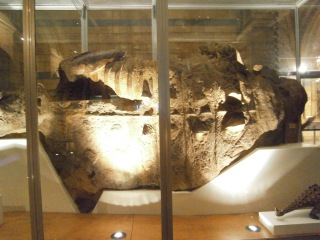I’m back in civilization, so let’s get back to ankylosaurs! Ready Set Go! Continue reading
know your ankylosaurs
Know Your Ankylosaurs: North American Odds and Ends Edition
I’ve covered many of the North American ankylosaurs in my previous papers and blog posts. In 2013, I argued that what we thought was Euoplocephalus was more likely 4 taxa – Anodontosaurus, Dyoplosaurus, Scolosaurus, and Euoplocephalus proper. Then in 2014 we described a newankylosaurid, Ziapelta, from New Mexico. There are a few other taxa that had previously been proposed to be ankylosaurids, so let’s take a look at them here.
Know Your Ankylosaurs: Gondwana Edition
Last time, I talked about the ankylosaurids of China, and today we’re talking about Gondwanan ankylosaurs. Gondwana basically refers to the continents of today’s southern hemisphere; when the supercontinent Pangaea broke apart, it split into two large continents – Laurasia in the north, and Gondwana in the south. Gondwana includes South America, Africa, Australia, and Antarctica, and, somewhat nonintuitively, India (India kind of beelined into Asia from Australia and that’s why we have the Himalayas). Almost all of the ankylosaurs we know about are from the Laurasian continents, which means that the few found in Gondwana are phylogenetically and biogeographically interesting: do they represent southern branches of the ankylosaur family tree, or new migrations into Gondwana from Laurasia? Let’s take a closer look:
Know Your Ankylosaurs: China Edition
I’m in Utah digging up dinosaurs! But also, one of the last big chunks of my PhD thesis has just been published online at the Journal of Systematic Palaeontology. They are generously allowing free access to the paper through the end of August, so head on over and grab a copy while it’s free! This time, I’m taking all of the knowledge gained from my previous taxonomic revisions, adding in some more taxa, and doing a revised phylogenetic analysis building on previous analyses to see how everyone shakes out and to learn a little bit more about ankylosaurid biogeography. I’ll cover some of the taxonomic stuff over the next few posts, and finish off with the big picture of ankylosaurid evolution.
Know Your Ankylosaurs: Mongolia Edition!
After a whirlwind couple of weeks with a bunch of international travel, I’ve finally had a chance to sit down and write about my most recent paper on the ankylosaurs of the Baruungoyot and Nemegt formations of Mongolia. I’ve been interested in these ankylosaurs for a long time now, both because of their interesting cranial anatomy and their relationships to the ankylosaurs of North America (especially Alberta). So, here’s a plain-language summary of some complicated taxonomy! Hooray! Continue reading
Know Your Ankylosaurs: New Mexico Edition!
There’s a new ankylosaur in town – meet Ziapelta sanjuanensis from the Cretaceous of New Mexico!
Hello, Ziapelta! Many thanks to new Currie Lab MSc student Sydney Mohr for this wonderful life restoration of Ziapelta.
Nitpicking Euoplocephalus
A friend of mine posted this amazing video on Facebook, and I must share it!
I really like how the Geek Group have obviously put a lot of time into researching the anatomy of the dinosaurs they’re featuring, and the stylized animations are super cool. I’m obviously biased towards this episode, but I’m looking forward to seeing more!
For those who are interested in learning more about the anatomy of Euoplocephalus, may I offer these blog posts?:
Baron von Nopcsa, Scolosaurus, and the spiky-clubbed ankylosaur.
Who-oplocephalus
Who-oplocephalus: Is Euoplocephalus ‘real’?
Who-oplocephalus: Heads for tails.
Who-oplocephalus: The Fellowship of the Half Ring
Who-oplocephalus: Everything old is new again.
And for the keeners, you can also check out a lecture I did for the Royal Tyrrell Museum’s lecture series via their YouTube page!
Bonus: The Dinosaur Toy Blog also enjoys nitpicking the accuracy of dinosaur toys!
Who-oplocephalus: Everything old is new again.
Over the last few posts, I’ve talked about why Euoplocephalus tutus is a valid genus and species, how the Horseshoe Canyon Formation ankylosaurid is really Anodontosaurus lambei, and how the headless and clubless holotype of Scolosaurus cutleri is most likely the same species as the ankylosaurid from the Two Medicine Formation. Here’s a diagram summarizing some of the key points from the paper.
Who-oplocephalus: The Fellowship of the Half Ring
Behold, NHMUK R5161: the extraordinary holotype of Scolosaurus cutleri. This is truly one of the most amazing dinosaur fossils that has been collected from Alberta, and is one of the best preserved ankylosaurs in the world. And the best part is that it is on display for everyone to enjoy in the galleries of the Natural History Museum in London.
(Many thanks to Angelica Torices for snapping this photo for me! NHMUK R5161 is beautiful to look at, but difficult to photograph well, and I’m afraid most of my photos from my visit in 2009, while useful to me, are not necessarily that nice to look at.) Continue reading
Who-oplocephalus: Heads for Tails.
With the identification of UALVP 31 as a specimen that could be confidently referred to Euoplocephalus based on the shape of the cervical half ring, I now had a pretty complete skull, and some postcranial material, to help expand our knowledge of Euoplocephalus.
The Euoplocephalus skull UALVP 31. From Arbour and Currie (2013).
Continue reading



